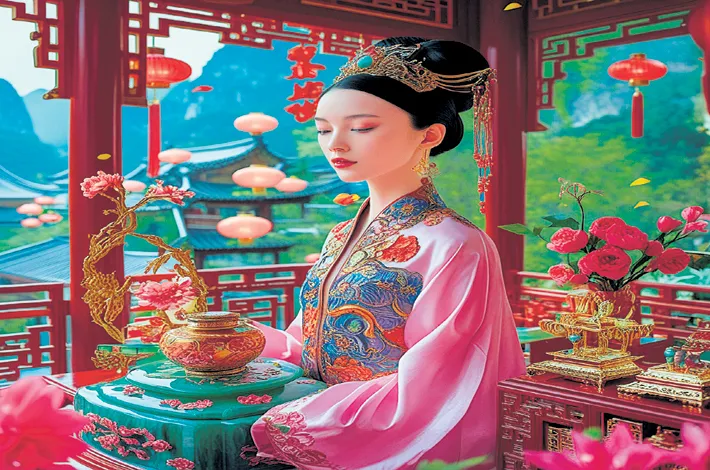The Evolution of Chinese Luxury
22-04-2025 12:00:00 AM

China’s luxury market has undergone a dramatic transformation over the past two decades. Once primarily known for mass production, the country has shifted toward cultivating a reputation for high-quality, exclusive craftsmanship. This shift is driven by a growing class of affluent Chinese consumers and a global demand for unique, culturally rich products. Chinese luxury brands are now blending centuries-old techniques—such as jade carving, silk embroidery, and lacquerwork—with modern design sensibilities, creating items that resonate with both Eastern and Western aesthetics.
The rise of e-commerce has further propelled this trend, allowing Chinese luxury brands to reach a global audience. Platforms like Tmall Luxury Pavilion, JD.com, and international marketplaces such as Farfetch and Net-a-Porter have become go-to destinations for discovering these exclusive items. Additionally, many brands have their own sleek, user-friendly websites, offering seamless shopping experiences for discerning buyers worldwide.
Categories of Luxury Items Made in China
Jewelry and Accessories
Chinese jewelry designers are gaining international acclaim for their innovative use of traditional materials like jade, gold, and pearls. Brands like Qeelin and Chow Tai Fook are renowned for their exquisite craftsmanship, often incorporating Chinese cultural motifs such as dragons, lotus flowers, and bamboo. For instance, Qeelin’s Wulu collection, inspired by the mythical gourd symbolizing good fortune, features 18-karat gold and diamond pieces that exude elegance and cultural depth. These items are available on Tmall Luxury Pavilion and Farfetch, with prices ranging from $2,000 to over $50,000 for limited-edition pieces.
Another standout is Anna Hu, a haute joaillerie brand that combines Chinese heritage with French techniques. Hu’s one-of-a-kind creations, like her silk-inspired diamond necklaces, are often sold through exclusive online auctions on platforms like Sotheby’s, fetching prices in the six-figure range. These pieces are not just accessories but wearable art, appealing to collectors and luxury enthusiasts.
Fashion and Textiles
China’s fashion scene has birthed several luxury brands that rival global giants. Shang Xia, backed by Hermès, is a prime example, offering minimalist yet sophisticated clothing, accessories, and home goods inspired by Chinese aesthetics. Their cashmere coats, handwoven with techniques passed down through generations, are available on their official website and select platforms like MatchesFashion, with prices starting at $3,000. Similarly, Uma Wang has gained a cult following for her avant-garde designs, blending silk and wool in ethereal dresses that retail for $1,500–$5,000 on Net-a-Porter.
Silk, a Chinese invention, remains a cornerstone of luxury fashion. Brands like Shanghai Tang elevate traditional qipao dresses with modern cuts and vibrant patterns, available online for $800–$2,000. These pieces celebrate China’s sartorial heritage while appealing to cosmopolitan tastes.
Home Décor and Collectibles
China’s luxury home décor market is thriving, with brands like Spin Ceramics and Tai Ping Carpets leading the charge. Spin Ceramics offers handcrafted porcelain vases and tableware, often glazed with techniques dating back to the Song dynasty. Their exclusive collections, priced between $200 and $10,000, are available on their website and select luxury retailers like Lane Crawford. Tai Ping, known for its hand-tufted rugs, collaborates with artists to create bespoke designs that can cost upwards of $20,000, available through their online showroom.
For collectors, Chinese luxury extends to rare items like Zisha teapots from Yixing, crafted from unique clay that enhances tea flavor. These teapots, often made by master artisans, can fetch $1,000–$100,000 on platforms like Christie’s or Alibaba’s Luxury Sou. Each piece is a testament to China’s tea culture and artisanal prowess.
Technology and Innovation
China’s tech giants are also entering the luxury space with exclusive gadgets. Huawei and Xiaomi have released limited-edition smartphones and smartwatches adorned with premium materials like ceramic and sapphire. For example, Huawei’s Mate X3 Porsche Design edition, priced at $2,500, features a leather finish and advanced foldable technology, available on Huawei’s global website. These devices cater to tech-savvy luxury consumers seeking both functionality and status.
Where to Shop Online
The accessibility of Chinese luxury goods has been revolutionized by e-commerce. Here are the top platforms to explore:
-Tmall Luxury Pavilion: Alibaba’s dedicated luxury platform hosts brands like Shang Xia, Qeelin, and Chow Tai Fook, offering a curated selection of exclusive items.
-JD.com: Known for authenticity, JD.com features high-end Chinese fashion and jewelry, often with global shipping options.
-Farfetch and Net-a-Porter: These international retailers stock Chinese designers like Uma Wang and Anna Hu, blending Eastern and Western luxury.
-Brand Websites: Many brands, such as Shanghai Tang and Spin Ceramics, have their own online stores with detailed product descriptions and customization options.
-Auction Houses: For ultra-exclusive items like Anna Hu jewelry or Zisha teapots, Sotheby’s and Christie’s online auctions provide access to rare pieces.
Challenges and Considerations
While Chinese luxury goods are gaining traction, buyers should be cautious of counterfeits, especially on less reputable platforms. Sticking to verified retailers like Tmall, Farfetch, or brand websites ensures authenticity. Additionally, international shipping costs and import duties can increase the final price, so it’s wise to check these details before purchasing.
The Future of Chinese Luxury
The global appetite for Chinese luxury goods is only growing, fueled by a desire for unique, culturally rich products. As Chinese brands continue to innovate and e-commerce platforms expand their reach, these exclusive items are becoming more accessible than ever. Whether it’s a jade-encrusted necklace, a handwoven silk dress, or a limited-edition tech gadget, China’s luxury offerings are redefining what it means to indulge in opulence.
In conclusion, the world of exclusive luxury items made in China is a vibrant, evolving landscape. Available through sophisticated online platforms, these products combine heritage, craftsmanship, and modernity in ways that captivate global consumers. For those seeking to invest in something truly special, exploring China’s luxury market online is an exciting journey into a new era of extravagance








